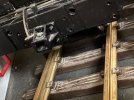baldwin 47
Registered
Hi
I am a new member and I’m basically asking people for advice and information about a current project that I am working on.
I am trying to work out the best way to correct one of the issues with the LGB White Pass 2-8-2 no73, namely the well known fact that the drivers are too large.
I am considering replacing the drivers with new ones closer to the 44” examples of the prototype and replacing the frame and using the original cylinders and valve gear as much as practicable.
Adjustments to accommodate the differences in ride height and spacing of drivers including lowering the cylinders, and other factors would all have to be addressed.
Ultimately I would like to keep the components available to reverse the entire process should I decide to sell at some point.
My intention would be to have the new frame and running gear as an unpowered unit but able to roll freely.
I would think that the new frame could be fabricated in brass or 3D printed, and the wheels would have to have the same throw as the original to allow some use of the model’s rods and valve gear as much as possible.
Has anyone done this before?
Any ideas would be greatly appreciated, especially regarding the design of the frame and its suitability for 3D printing, perhaps in sections due to the size of the wheelbase.
Cheers baldwin47
I am a new member and I’m basically asking people for advice and information about a current project that I am working on.
I am trying to work out the best way to correct one of the issues with the LGB White Pass 2-8-2 no73, namely the well known fact that the drivers are too large.
I am considering replacing the drivers with new ones closer to the 44” examples of the prototype and replacing the frame and using the original cylinders and valve gear as much as practicable.
Adjustments to accommodate the differences in ride height and spacing of drivers including lowering the cylinders, and other factors would all have to be addressed.
Ultimately I would like to keep the components available to reverse the entire process should I decide to sell at some point.
My intention would be to have the new frame and running gear as an unpowered unit but able to roll freely.
I would think that the new frame could be fabricated in brass or 3D printed, and the wheels would have to have the same throw as the original to allow some use of the model’s rods and valve gear as much as possible.
Has anyone done this before?
Any ideas would be greatly appreciated, especially regarding the design of the frame and its suitability for 3D printing, perhaps in sections due to the size of the wheelbase.
Cheers baldwin47


